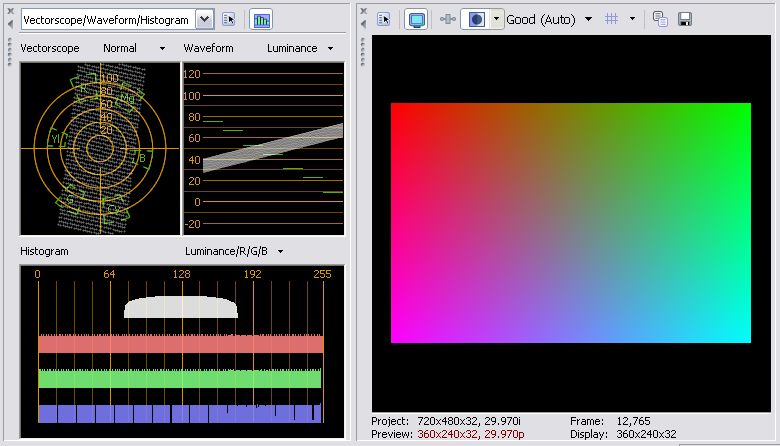Not quite sure what numbers you want but Vegas and Canopus both use standard SMPTE bar chroma levels. Luminance numbers are evident from the green markers on the vegas waveform monitor.Originally Posted by vhelp
BTW, as stated, I'm using the DV/DVD (ref CCIR-601) levels color bar.
+ Reply to Thread
Results 31 to 44 of 44
-
-
I unnessarily cluttered my previous post lets see if we can clean that up. (thrasimacus, are the histograms hijacking your thread? If so well start another one)
SVHS vs VHS
SVHS retains more luminance and color information than VHS, this is clearly shown by the waveform and histograms, but is irrelevant to our discussion. For some reason I thought it was important. Throwing out SVHS screen shots.
EDTV likes luminance waveforms, I have never used a waveform monitor so I included the RGB data with the luminance data. This confused my waveforms, throwing out RGB waveform.
@EDTV
I am very interested in what happens to RGB data at 7.5 IRE, I believed it would be left alone now it seems the ADVC-100 has munged (technical term) the RGB data when adjusting luminance. EDTV please include histograms showing both RGB and luminance in your posts. Pretty please.
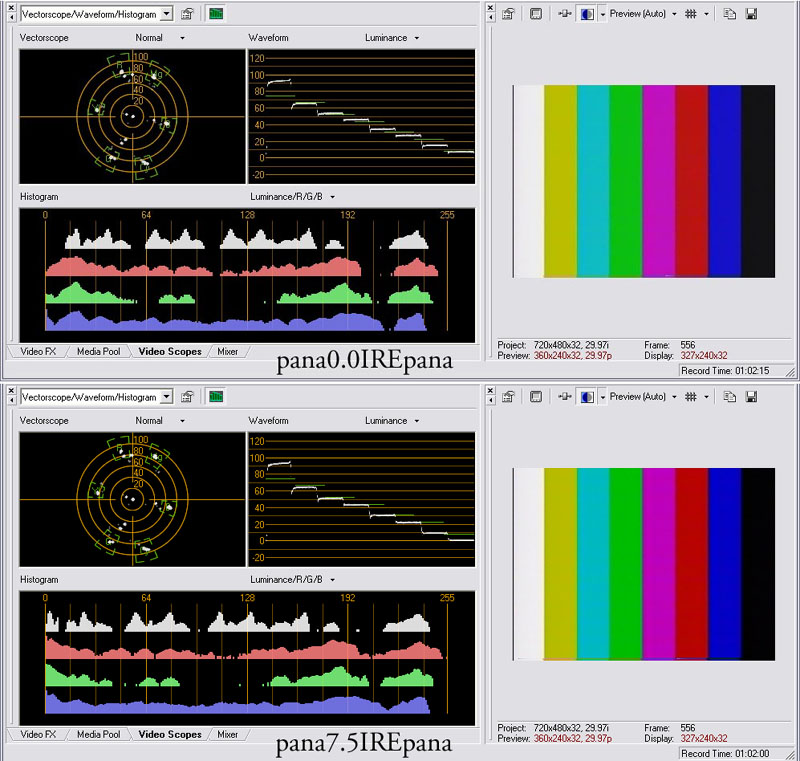
First we have VHS colorbars with ADVC switch set to 0.0 IRE.
Waveform shows black at 8.0 IRE and white at 93.0 IRE.
Histogram shows black at 12 and white at 242 (luminance 12-242). OK.
Second, VHS colorbars with ADVC switch at 7.5 IRE.
Waveforms show black at 0.0 IRE and white at 94.0 IRE.
Histograms show black at 0 and white at 244 (luminance 0-244)
I am not trying to explain it, this is just what I see. If everyone agrees I didnít label the screenshots backward we can continue. If this is absolutely wrong please tell me. -
I guess I see in YUV and you see in RGB

The reason I like luminance is that is what is being directly recorded to tape along with U and V for DV or modulated subcarrier C for VHS/S-VHS. RGB is calculated for display in the histograms and the conversion formula seems to be mapped to a 0-255 scale. This has an indirect relationship to recorded levels.
As requested, I'll post the Vegas calculated histograms for the images above.
First the reference colorbar. A color bar only has a few RGB values.
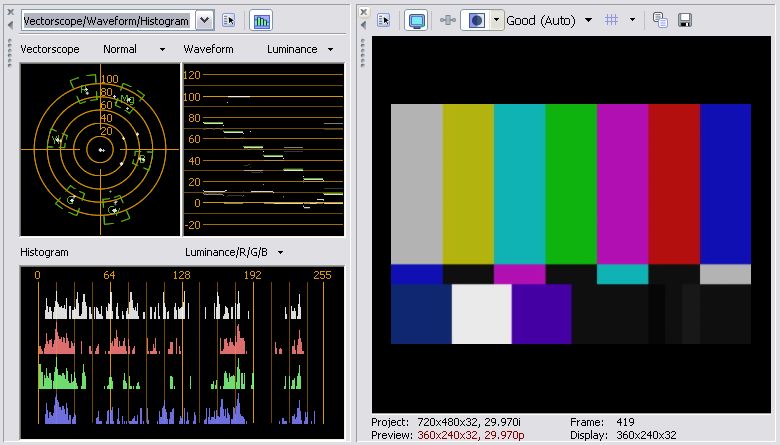
Next the ADVC in 0.0 mode OFF

Next the ADVC in 7.5 mode ON
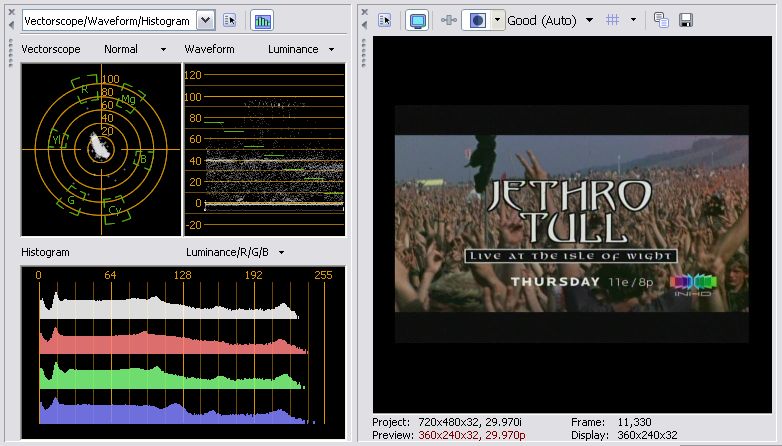
I notice strong RGB values in being used in graphics and effects intensive work (artificial). Like the Nascar graphics here.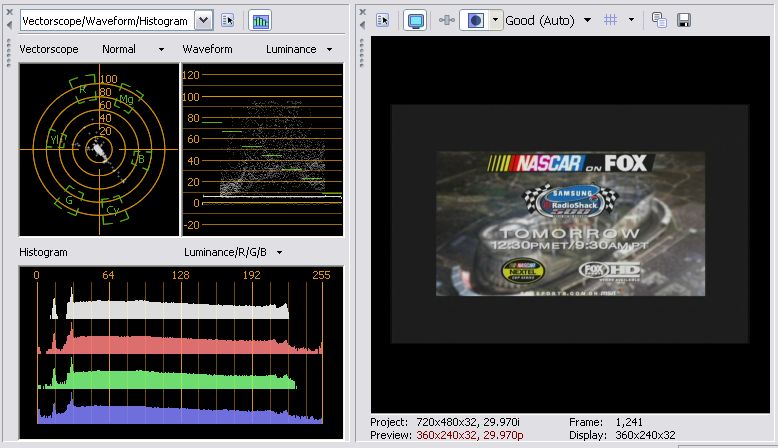
Vegas has a test pattern called gradient. It produces a flat full spertrum of RGB from 0-255. You might want to try that. My ADVC is busy recording the Pixies on Austin City Limits.
Note that the levels showing near zero are due to blanking entering the picture on the extreme left and right. Don't confuse that with actual picture content. -
First off...Has it been established this unit defeats the new MV?
Secondly, per readings here, didn't you come across some threads where it was established that the Canopus 100/110 oversaturates the color to "make up" for transfer loss? I believe it was established that the similar and highly rated DataVideo DAC-100 doesn't oversaturate and has more true color with more information actually being transferred. -
First I don't have a 110 so I can't say first hand.Originally Posted by zoobie
Second, explain to me where you are seeing oversaturated color in my or holdar's tests above? It appears to me that chroma saturation is dead on or at least very close.
Look here how the color dots fall to the center of the vector boxes. That is dead on saturation. The luminance is about 7% low in this test but as said before, that could be the camcorder's NTSC output. It needs to be retested with a calibrated source.
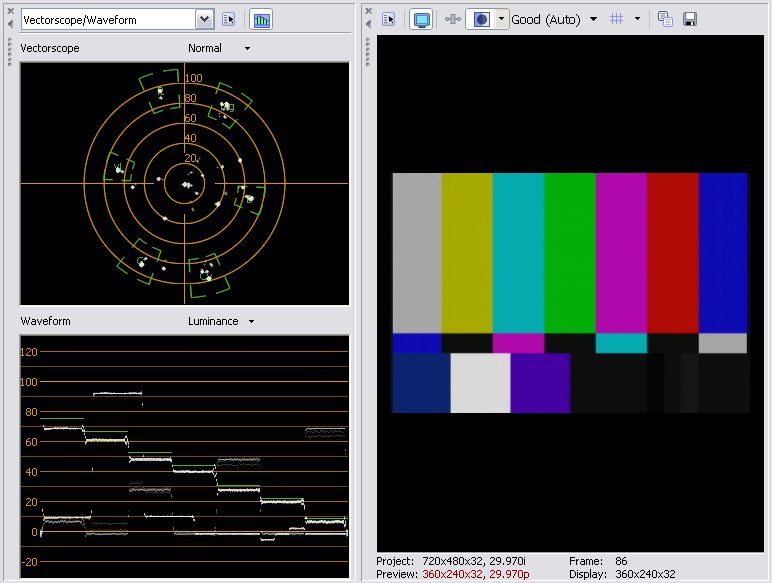
In yesterday's test, I recorded the ADVC's color bar to a JVC S-VHS HR-S4800U (using VHS tape) and then captured back with near perfect luminance and chroma levels. Result repeated here.
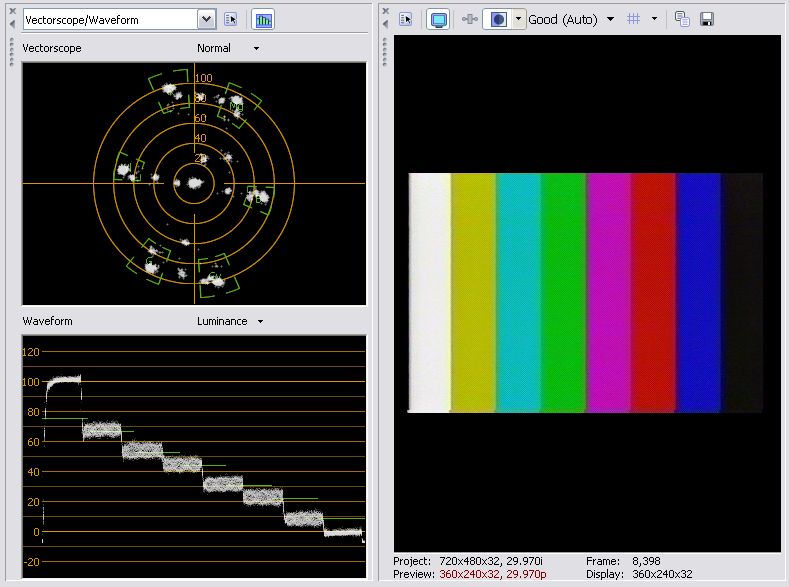
So whomever is claiming oversaturated colors needs to demonstrate that is the case.
And what is "transfer loss"? -
Nope. Don't do that. This couldn't be any more on topic.(thrasimacus, are the histograms hijacking your thread? If so well start another one)
Thanks for all the help I am getting.
Also thanks edDV for your interesting idea. I had to work today but I tried a few things late night. I don't have a canopus 100/110 so I couldn't do what you proposed.
What I did was I took a B&W vid and tried to cap in Vegas using the AIW card, by-passing the AIW capture software (you can't by-pass the AIW driver if you use AIW as hardware).
So... I used Vegas to capture via S-video. Then I looked at the scopes. I didn't find anything strange that jumped out at me. I found it to be inconclusive. Vegas cap does have a proc function and by reducing the contrast a little I got the luminance to stay between ~7 and ~235.
Things are getting a bit too technical, this is good and bad. The bad is that getting too technical often leads to mistakes since we are not sufficiently
trained and I doubt anyway that there are many in the world that totally understand every aspect on this issue in the technical way. Second, a lot needs to be posted to clarify ideas and actions. There is so much on my mind that I would have to write pages & pages just to make sure I am clearm concise so no missunderstands occur... Of course then there is the positive that needs not be elaborated on.
My main issue here is this. If I reduce the contrast/gain, yes the "white" is fixed but the problem is that the contrast for the entire picture is reduced. To be more clear, something photoshop users, and perhaps vegas users would understand, making such a change applies to the entire picture. It would be better if I could adjust the contrast individually for low, medium, and high shades. You have no limits in photoshop in this regard. In Vegas you can do a color, etc adjust like this too individually for low, mid, high shades (not unlimited but making 3 instead of 1, makes it something that can fix without breaking). The problem is that the capture proc in Vegas only has 1 universal slider (just like AIW capture software). This can fix, but it also almost always breaks. Most people versed in Photoshop know not to use the contrast/brightness slider. Instead use the curves. The same principles apply to video. Just need the tools to apply the principle.
If I was to get an external proc, it would have to have 'sliders' by shade (at least 3 shades: low, mid. high) or it would be totally useless for my needs.
Anyway, thanks again. I didn't have time to read all the posts but I will. Please don't take my lack of replying as an insult or me not appreciating yourhelp. I need some time to digest the info. -
First a concept. Vegas has no capture proc amp controls. It just allows access to ATI capture menus.Originally Posted by thrasimacus
I have the AIW 8500DV and MMC 9.02. The basic controls ATI provides for capture are brightness, contrast, hue and saturation. The bad news about Vegas is the scopes don't work with live inputs. You have to capture first to use the scopes. And then use trial and error. This is a serious departure from professional practice.
So, you will need to eyeball adjust the ATI, check levels later, then repeat. The sequence of controls to try is:
1. Set brightness for black. That's right "brightness" sets your black level.
2. Set contrast for exposure. Get a good white without blooming, then back off a bit.
3. Set saturation (color level)
4. Set hue
5. Capture, check the scopes, and repeat with small changes as necessary.
6. Then capture the scene. You may need to make small adjustments scene by scene.
You will find photoshop type controls in Vegas's Plug-In filters. Use these for fine adjustments. Start with "Color Balance" and you will feel at home.
Feel free to ask more. I'm going away for 2 weeks but will look in when I can get online.
Others will help I'm sure. -
Iím going to put this up and keep trying to find a clear explanation. I have been reading some posts by trevlac on how IRE is mapped into RGB 0-255, but I donít see my answer yet.
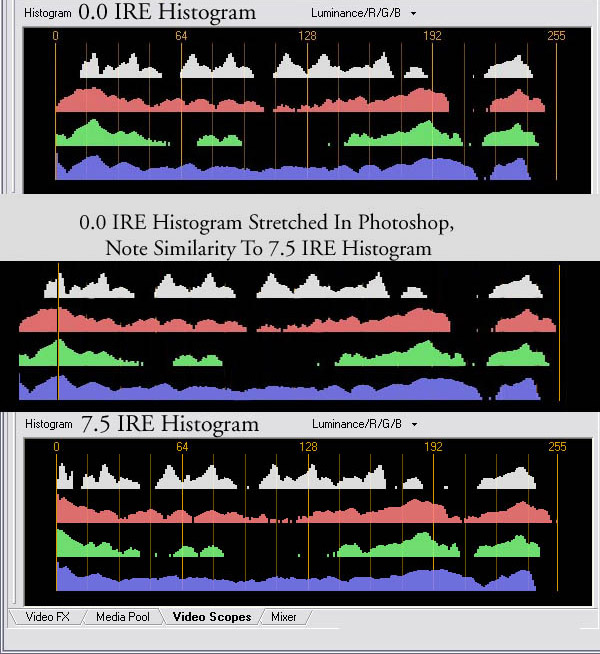
Clearly when we talk about the difference between 0.0 IRE and 7.5 IRE we are talking about different mappings on the same data. So what is the process.
First, there is a reduction of luminance spectrum (if thatís the right word) from 256 levels (0-255 ) to 220 levels (16-235 ), so we are talking about a lot less data. Second, if 220 levels are remapped into 256, the image data has been degraded twice before you even begin processing . -
A quick post but I'm short on time.
The DV and DVD spec calls for Y U V encoding. The RGB graphs are just a conversion for monitoring.
The luminance spec calls for black at 16 and white at 235 for reasons I explained above. Those are your digital 0 and 100 IRE levels. The headroom is there to carry overshoots without clipping. Clipping occurs at approx 108 IRE.
This is exactly the way all broadcast specs work. It is exactly what your DVD player expects to be on the DVD.
If you use different levels, you will need to readjust your TV for your special levels each time you play the disc.
Please be more clear what your concerns are and if your intention is to make a DVD that meets spec.
The 0.0 mode is expecting analog black at 0.0 IRE. The A/D will map this to 16 and 100 IRE white to 235.Originally Posted by holdar
The 7.5 mode is expecting analog black at 7.5 IRE. The A/D will map this to 16 and 100 IRE white to 235.
Overshoots up to 108 IRE (8%) will also be mapped to digital levels 236-255.
This applies to analog to digital conversion to the DVD spec as written. The guard bands are there for a purpose.Originally Posted by holdar
Maybe this will help.
http://www.adamwilt.com/DV.html
specifically
http://www.adamwilt.com/DV-FAQ-tech.html#Setup -
holdar,
Here are the formulas for YUV to RGB conversion This is being done to generate the RGB graphs in Vegas.
http://www.fourcc.org/index.php?http%3A//www.fourcc.org/fccyvrgb.php -
@EDTV wrote:
So I should stop worrying about the Luminance/RGB histogram and pay more attention to the Luminance waveform. Point taken.The DV and DVD spec calls for Y U V encoding. The RGB graphs are just a conversion for monitoring.
@EDTV wrote:
Sorry if I gave the impression I want to send out of spec data to a TV. I think we all agree there is no point sending a TV out of spec data.Please be more clear what your concerns are and if your intention is to make a DVD that meets spec
My question is at what point is it best (for me) to make sure the data is TV safe (in spec). I capture the DV stream, process with Avisynth, and frameserve to TMPGenc. So far I feel better if the last step in the chain before TMPGenc worrys about a TV safe image.
I believe this gives me greater latitude with Avisynth/Levels/ColorYUV to bring up detail lost in shadows, and tone down whites close to washout. Since my sources are either broadcast or VHS if anything is chopped off before I get a chance to play with it I feel cheated. I want to capture as much information as possible. Massage it to the best of my abilities. And, as part of the last step, make sure everything is TV safe.
90% of my processing is B&W VHS, VHS is bad enough, B&W is double trouble. A friend of mine who only does color likes deep blacks, some washedout whites, and TWEAKed saturation, he calls it ďTechnicolor PopĒ. If you have color information you can get away with that because you have a lot more bits to play with. With only shades of gray its sometimes difficult to get detail on both a dark jacket and white shirt, and still have some black to make the image ďPopĒ. An example of a failure and one of the worst transfers Iíve ever seen is the Criterion Collection: The 39 Steps by Alfred Hitchcock, everything looks washedout.
P.S. Thanks for the great links -
Y = B&W so it would seem Y should be your focus. Be careful of using any filters that convert the image to RGB. Setting correct black level is crutial to making B&W look good.Originally Posted by holdar
I encourage you to use a TV monitor for quality judgement. A TV is very different in display properties. Burn a test DV or use Vegas to get a good TV feed. Put correct SMPTE color bars and stair step test patterns on the DVD so you can calibrate the TV. Remember that the DVD player is going to add 7.5 IRE to the blacks if you're in a NTSC territory. A correct image will look very dark on a computer monitor. An image that looks good on the computer monitor will look overbright and washed out on a TV.
Remember that although white is defined at 100 IRE you can play with that area between 100 and 108 IRE (236-255) for highlights and edges so long as you aren't looking to submit it for broadcast. Avoid putting too much weight up there or the TV AGC circuit will try to compensate ruining the effect. Try to find a good B&W transfer (maybe a different Crterion DVD) and study the waveforms. It may give you clues to getting the look you want.
I wish Avisynth and TMPGenc had the scopes so you could see what you are doing to levels. Pro effects houses use scopes for every step. With 8bit video you can loose grayscale quickly if you process levels more than once. All I can think of is make a test MPeg2. Look at it with Vegas scopes and if good, burn a test DVD-RW and view it on a TV. Then repeat.Originally Posted by holdar
Hope some of this helps. -
My two cents and FWIW ...
I think that there is a first step that needs to be looked at here.
I know I've mentioned it a few times in past posts before, but I am
mentioning it again here.. The INPUT and OUTPUT files.
.
The Encoded OUPUT source file should match that of the INPUT source
file.. color space 'wise. The OUTPUT source file is the MPEG-2 encode.
Thus, OUTPUT = INPUT.
.
Because (I repeat) DV is already YUV, when encoded to MPEG
(lets assume, MPEG-2) its YUV (color space level) should
in fact, match that of the YUV INPUT source. This works for me
every time, when I prepare TMPGenc for the encode of my DV source
file. But, bare in mind, my comment below on DV 's YUV.
Anyways.
With great respect to DV format, I think there is also, a missing piece
from it too. But, I theorize that it starts with the conversion process
first. That is, when the source (being captured through the lens) is
being first processed, and then converted to YUV (assuming, from RGB)
that the missing piece here, is that of with the conversion formula used.
(But, weather captured through Lens, or Analog, the same applies with
color space conversion)
.
That is what I feel is the missing piece. What *IS* the RGB to YUV formula
being used in a particular DV device (ie, be it a DV CAM or ADVC for instance)
.
I believe, that once we know for sure, the exact conversion formula, and
assuming that the same formula is used through out all the DV devices (a
very far cry from truth) we can use its "inverse" to obtain the TRUE
RGB values. So, once we know the actaul conversion used, we can apply that
same formula in our own process, and get maximum DV reproduction and w/out
any ill-effects along with it. But this is all dependant upon weather or
not all facets of DV use the same formula throughout, and weather or not
the conversion (through the formula) is throwing out some values or not.
.
If (I speculate) that DV vs. MPEG is using two different color space
formula's (at least in our el-cheapo encoders) that could help explain
some of the oddities in out INPUT vs. OUTPUT (or, OUTPUT != INPUT)
When we process a given video (assuming we're talking about a capture
project) we want out final encoded MPEG to match that of the SOURCE avi
file. Weather it be DV or Huffy or RGB doesn't (or shouldn't) really
matter that much. They just have to match the INPUT source.. specially
for DV, since DV is YUV based, just as MPEG is YUV. About the only
difference between DV and MPEG is the area of sampling. YUV (NTSC)
uses 4:1:1 sampling, while MPEG-2 uses 4:2:0 sampling. But, for the
most part, the color space is pretty much the same. But, you can
tell if there are any differences between the two, when you encode
the DV to MPGE, and then compare the two together. They should
math perfectly as long as the user did not alter the color attributes
inside the editing/encoding process.
.
But, a part of the problem is just how far one has to go when they
incorparate some color filtering, weather hardware or software. That
is another factor to consider when trying to obtain OUTPUT = INPUT,
because this step will surely mess up the color balance no doubt.
.
But, in order to apply the above O = I, and a gauge thereof, one has to find
the right method to accurately measure a given INPUT source for color space
level. Currently, I don't think there are any in existance because there
are too many variables and variance. However, we can all come to some
sort of consensus on some measurements (that we all can perform, and w/
little to no limits to users expense) and consistantly produce the
same results. But that has to be designed and debugged. Anyways.
And, let me repeat (from previous posts) that the following, is my
belief:
* IRE 0 = 16-235
* IRE 7.5 = 0-255
.. It is my opinion, that the following are IRE 0 (16-235) space..
.. * VCR; TV; Laserdisc
.. .
.. and that the following, are IRE 7.5 (0-255) space..
.. * DVD
.. .
.. Note, there are some variance in this note above. Some dvd players
.. do not follow this same rule.. (ie, my AD-500 does output in sRGB,
.. (or, 16-235 -- otherwise known for slight washout look)
.. .
.. And, also.., that some dvd players reproduce the color space, with
.. spot-on accuracy. However, that is only a temporary theory, until
.. I can test this fully.
Anyways.
I coded up a small utility (based off an already made tool for color RGB
references, but I revised and added in some useful ideas of my own) ..and what
it does is produce two sets of color bars.
.
One set is for the normal 0-255 space, and another set is for the 16-235 space.
But, I addded in the ability (for experimental purposes) to scaled both the
X,Y (or, MIN/MAX) color range. So, the 16 (call it the left side) is scaleable,
and the 235 (right side) is also scaleble. Every color bar will change pitch,
(color range) through the RGB-to-YUV and back, conversion formula.
.
.. Note, it took me a very long time to find the right formula, and a gazillion
.. trial n error test runs, before the tool actually worked.
.
What I would like to do next, is set this up, so that it OUTPUTS a bitmap
as an AVI, and follow it with an Encode, and verify the color space (weather
it be 16-235 or 0-255 space) and see if the formula above (as well as my
theory) holds true. But, this requires more work, as well as more learning
So, perhaps it's a work in progress. Anyways.
.
With a home-made 0-255 and 16-235 space BITMAP (or, AVI) source as *THE*
official gauge to work with, truer results can be obtained, etc. yada; yada; yada.
The pic below can be meaured with your color picker app. Whatever the tool
of your choice is, when working with images go. Just measure the top color
bars against the bottom lower ones. My next step in this step, is to take
that color bar image (below) who's range is 0-255, convert to 16-235 (image
below) and encode it to MPEG.., then try and convert it back to 0-255 space,
using the same conversion formula. (as soon as I figure out how to take a
given bitmap and covert to YUV, and save that YUV data inside the bitmap
or STREAM file, and back, I can move on in these tests)
.
.. If some users are experiencing different results in there own set of
.. experiements in color space w/ 0-255 vs 16-235, I would suspect that its
.. on account of the conversion formula(s) being used. Both formulas *MUST*
.. match - what goes in, must come out the same. Plus, your given formulas
.. may not be the same as that of commercial tools/apps/players etc.
.
Feel free to examine the pic at your own leasure:

-vhelp 3273
Similar Threads
-
Capturing issue with Canopus ADVC-110
By nharikrishna in forum Capturing and VCRReplies: 6Last Post: 24th Aug 2011, 12:30 -
Macrovision and Canopus ADVC 110
By nikgelfi in forum Capturing and VCRReplies: 2Last Post: 13th Apr 2011, 17:09 -
Canopus ADVC-100 vs Canopus ADVC-110
By tarrickb in forum Camcorders (DV/HDV/AVCHD/HD)Replies: 20Last Post: 16th Oct 2010, 21:52 -
Canopus ADVC 110 Possible problem?
By Drexter in forum Capturing and VCRReplies: 4Last Post: 20th Feb 2010, 22:10 -
Canopus ADVC-55 vs. ADVC-110
By bcags7 in forum Capturing and VCRReplies: 4Last Post: 2nd Nov 2008, 16:15





 Quote
Quote